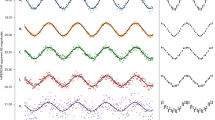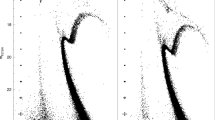Abstract
White dwarfs are the remnant cores of stars that initially had masses of less than 8 solar masses. They cool gradually over billions of years, and have been suggested1,2 to make up much of the ‘dark matter’ in the halo of the Milky Way. But extremely cool white dwarfs have proved difficult to detect, owing to both their faintness and their anticipated similarity in colour to other classes of dwarf stars. Recent improved models3,4,5 indicate that white dwarfs are much more blue than previously supposed, suggesting that the earlier searches may have been looking for the wrong kinds of objects. Here we report an infrared spectrum of an extremely cool white dwarf that is consistent with the new models. We determine the star's temperature to be 3,500 ± 200 K, making it the coolest known white dwarf. The kinematics of this star indicate that it is in the halo of the Milky Way, and the density of such objects implied by the serendipitous discovery of this star is consistent with white dwarfs dominating the dark matter in the halo.
This is a preview of subscription content, access via your institution
Access options
Subscribe to this journal
Receive 51 print issues and online access
$199.00 per year
only $3.90 per issue
Buy this article
- Purchase on Springer Link
- Instant access to full article PDF
Prices may be subject to local taxes which are calculated during checkout

Similar content being viewed by others
References
Chabrier,G., Segretain,L. & Mera,D. Contribution of brown dwarfs and white dwarfs to recent microlensing observations and the halo mass budget. Astrophys. J. 468, L21–L24 (1996).
Alcock,C. et al. The MACHO project Large Magellanic Cloud microlensing results from the first two years and the nature of the Galactic dark halo. Astrophys. J. 486, 697–726 (1997).
Hansen,B. M. S. Old and blue white-dwarf stars as a detectable source of microlensing events. Nature 394, 860–862 (1998).
Hansen,B. M. S. Cooling models for old white dwarfs. Astrophys. J. 502, 680–695 (1999).
Saumon,D. & Jacobsen,S. B. Pure hydrogen model atmospheres for very cool white dwarfs. Astrophys. J. 511, L107–L110 (1999).
Liebert,J., Dahn,C. C. & Monet,D. G. The luminosity fraction of white dwarfs. Astrophys. J. 332, 891–909 (1988).
Luyten,W. J. NLTT Catalog (Univ. Minnesota Press, Minneapolis, 1979).
Winget,D. E. et al. An independent method for determining the age of the universe. Astrophys. J. 315, L77–L81 (1987).
Wood,M. A. Constraints on the age and evolution of the Galaxy from the white dwarf luminosity function. Astrophys. J. 386, 539–561 (1992).
Leggett,S. K., Ruiz,M. T. & Bergeron,P. The cool white dwarf luminosity function and the age of the Galactic Disk. Astrophys. J. 497, 294–302 (1998).
Oswalt,T. D., Smith,J. A., Wood,M. A. & Hintzen,P. A lower limit of 9.5 Gyr on the age of the Galactic disk from the oldest white dwarf stars. Nature 382, 692–694 (1996).
Knox,R. A., Hawkins,M. R. S. & Hambly,N. C. A survey for cool white dwarfs and the age of the Galactic Disk. Mon. Not. R. Astron. Soc. 306, 636–752 (1999).
Ruiz,M. T. New cool degenerate stars. Astron. J. 111, 1267–1270 (1996).
Festin,L. The luminosity function of white dwarfs and M dwarfs using dark nebulae as opaque outer screens. Astron. Astrophys. 336, 883–894 (1998).
Flynn,C., Gould,A. & Bahcall,J. N. Hubble Deep Field constraint on baryonic dark matter. Astrophys. J. 466, L55–L58 (1996).
Elson,R. A. W., Santiago,B. X. & Gilmore,G. F. Halo stars, starbursts, and distant globular clusters: A survey of unresolved objects in the Hubble Deep Field. New Astron. 1, 1–16 (1996).
Mendez,R. A., Minniti,D., de Marchi,G., Baker,A. & Couch,W. J. Starcounts in the Hubble Deep Field: Constraining Galactic structure models. Mon. Not. R. Astron. Soc. 283, 666–672 (1996).
Graff,D. S., Laughlin,G. & Freese,K. MACHOs, white dwarfs and the age of the universe. Astrophys. J. 499, 7–19 (1998).
Tamanaha,C. M., Silk,J., Wood,M. A. & Winget,D. E. The white dwarf luminosity function—A possible probe of the Galactic Halo. Astrophys. J. 358, 164–169 (1990).
Hambly,N. C., Smartt,S. J. & Hodgkin,S. T. WD0346+246: A very low luminosity, cool degenerate in Taurus. Astrophys. J. 489, L157–L160 (1997).
Hambly,N. C. et al. On the parallax of WD0346+246: a Halo white dwarf candidate. Mon. Not. R. Astron. Soc. 309, L33–L36 (1999).
Harris,H. C. et al. A very low-luminosity, very cool, DC white dwarf. Astrophys. J. 524, 1000–1007 (1999).
Borysow,A., Jørgensen,U. G. & Zheng,C. Model atmospheres of cool, low-metallicity stars: the importance of collision-induced absorption. Astron. Astrophys. 324, 185–195 (1997).
Wood,M. A. in White Dwarfs (eds Koester, D. & Werner, K.) 41–45 (Springer, Berlin Heidelberg, 1995).
Ruiz,M. T., Bergeron,P., Leggett,S. K. & Anguita,C. The extremely low luminosity white dwarf ESO 439-26. Astrophys. J. 455, L159–L162 (1995).
Ryan,S. G. & Norris,J. E. Subdwarf studies. II—abundances and kinematics from medium resolution spectra. Astron. J. 101, 1835–1864 (1991).
Dahn,C. C., Liebert,J., Harris,H. C. & Guetter,H. H. in The Bottom of the Main Sequence—and Beyond (ed. Tinney, C. G.) 239–248 (Springer, Berlin Heidelberg, 1995).
Gizis,J. E. & Reid,I. N. M subdwarfs: the population II luminosity function. Astron. J. 117, 508–520 (1999).
Richer,H. B. et al. Isochrones and luminosity functions for old white dwarfs. Astrophys. J. (in the press).
Matthews,K. & Soifer,B. T. The near infrared camera on the W.M. Keck telescope. Exp. Astron. 3, 77–84 (1994).
Acknowledgements
The UK Infrared Telescope is operated by the Joint Astronomy Centre on behalf of the UK Particle Physics and Astronomy Research Council. Some of the data presented here were obtained at the W. M. Keck Observatory, which is operated as a scientific partnership among the California Institute of Technology, the University of California and NASA. The Observatory was made possible by the support of the W. M. Keck Foundation. S.T.H. and S.J.S. were supported by the PPARC; B.R.O. was supported by FUTDI and a Hubble postdoctoral research fellowship.
Author information
Authors and Affiliations
Corresponding author
Rights and permissions
About this article
Cite this article
Hodgkin, S., Oppenheimer, B., Hambly, N. et al. Infrared spectrum of an extremely cool white-dwarf star. Nature 403, 57–59 (2000). https://doi.org/10.1038/47431
Received:
Accepted:
Issue Date:
DOI: https://doi.org/10.1038/47431
This article is cited by
-
A bright future for dark matter
Nature (2000)
Comments
By submitting a comment you agree to abide by our Terms and Community Guidelines. If you find something abusive or that does not comply with our terms or guidelines please flag it as inappropriate.



